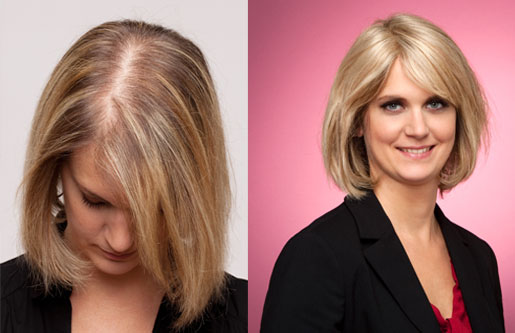Women Hair Loss
It is sad that many women experience distress and misery caused by the loss of hair. It is estimated that 25% of Caucasian women aged between 35 and 45 years and 35% to 40% of women in their fifties have a female androgenetic alopecia .. Alopecia is caused by a female predisposition androgenetic hair follicle with a normal or with growth in androgen, mild or severe. This type of hair loss is characterized by a diffuse thinning over the entire head, unlike the typical male pattern baldness. The hair becomes thinner and shorter making sure that the scalp becomes (sparse) visible through the hair.
Menopause can also be a contribution to hair loss in women. 20% of women experience hair loss following a decrease of female hormones. Testosterone already present at a normal level has a trigger effect on hair loss. It is important to find the underlying cause of your hair loss before it can begin processing. Our doctors (specialists) will team up with you to establish the reason you lose your hair, then suggest an appropriate treatment to restore not only the regrowth of them but you back your confidence.
There may be a number of causes of bald spots in women. Them during and after menopause are more likely to suffer excessive loss of hair on the scalp, but also to develop hair (body hair) on other parts of the body, especially on the face.
Here are some of the most common reasons for bald spots in women:
Alopecia Areata:
Alopecia areata is an autoimmune condition that can affect both men and women equally and local cause baldness. Alopecia areata is characterized by the sudden appearance of bald spots are usually round, but can take any other form. In addition to causing hair loss, alopecia areata can affect hair on other body parts. In this disease, hair follicles are mistakenly attacked by the body's immune system. In most cases, alopecia areata causes temporary hair loss, and thus growth (shoot, regrowth) of the hair can eventually resume.
Telogen effluvium:
The telogen effluvium is a common cause of baldness in women. Some of the most common factors that may cause telogen effluvium are: a major surgical procedure, excessive stress, childbirth, severe infections, thyroid problems and malnutrition. However, hair loss due to telogen effluvium usually grow back within two to three months of the occurrence (the appearance or disappearance) of the stressful event.
Fungal infection:
The fungal infection may be another possible cause bald patches or plaques in women. The fungal infection like ringworm can affect the scalp and hair loss. The bald spots caused by fungal infections appear as red patches (red spots dry and crumbly!) And scaly, fungal infection can also cause itching. Hair growth on the affected area may resume once the infection cured with proper treatment.
Androgenic alopecia
Androgenicing a alopecia, also known as male pattern baldness can cause hair thinnnd bald patches, mostly on the top and sides of the scalp. Androgenetic alopecia is due to the conversion of testosterone to dihydrotestosterone, or DHT. Androgenic alopecia can be genetic or it can affect women who have high levels of circulating androgens due to certain underlying conditions. It was observed that the most frequent causes of androgenic alopecia in women, the polycystic ovary syndrome, perimenopause and menopause, pregnancy and use of contraceptive pills, especially those with an index high androgens.




